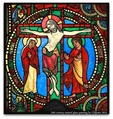Paints: acrylic and pigments
Powder Pigment technique
 egg tempera on archival paper
egg tempera on archival paper
Time tested techniques with color brilliancy known to last thousands of years.
1. Mixing pigments
with gum arabic, a professional gel medium,
or using the traditional egg binder.
All of these techniques involve a compliment of compatible natural and sometimes synthetic pigments. Works are sealed with a clear coat of choice. I prefer the non-yellowing, archival variety.
2. For traditional egg tempera
Using egg yolk as the binder. This ancient technique produces a water-soluble paint that dries quickly to an insoluble surface allowing for over painting with more tempera or other mediums. It is a very permanent technique.
As the artwork cures the paint undergoes a chemical
change and becomes very hard.
A light buffing on the cured board work will suffice in most cases. An additional layer of egg based sealer can be applied after approximately 6 months and will increase the final sheen on a cured piece. An alternative type of top sealer, like Ofilia, is not necessary, but an option (one of several). Really, this depends on the specific artwork, if it will be behind glass or not.
1. Mixing pigments
with gum arabic, a professional gel medium,
or using the traditional egg binder.
All of these techniques involve a compliment of compatible natural and sometimes synthetic pigments. Works are sealed with a clear coat of choice. I prefer the non-yellowing, archival variety.
2. For traditional egg tempera
Using egg yolk as the binder. This ancient technique produces a water-soluble paint that dries quickly to an insoluble surface allowing for over painting with more tempera or other mediums. It is a very permanent technique.
As the artwork cures the paint undergoes a chemical
change and becomes very hard.
A light buffing on the cured board work will suffice in most cases. An additional layer of egg based sealer can be applied after approximately 6 months and will increase the final sheen on a cured piece. An alternative type of top sealer, like Ofilia, is not necessary, but an option (one of several). Really, this depends on the specific artwork, if it will be behind glass or not.
 Chartres Crucifixion: to resemble glass
Chartres Crucifixion: to resemble glass
Acrylic
Acrylic paints use a type of plastic as the medium, or base, for the pigment (much as oil paint uses oil as the medium for the pigments), and this makes the paints much more durable than water-based paints like gouache or tempera. Acrylic paint was created in the mid 20th century research.
- professional grade acrylic
- sealed with an archival, UV protective, clear coat finish.
Acrylic paints use a type of plastic as the medium, or base, for the pigment (much as oil paint uses oil as the medium for the pigments), and this makes the paints much more durable than water-based paints like gouache or tempera. Acrylic paint was created in the mid 20th century research.